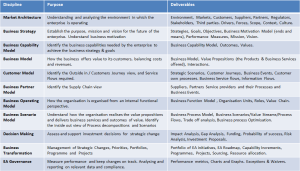http://thebusinessarchitect.accelare.com/2013/03/28/why-you-need-a-business-architecture/
I just returned from the OMG/BA Guild Business Architecture Innovation Summit where there was a lot of discussion on the subject of business architecture value. No one had a good answer for either creating a business case or measuring value delivered. This is a challenging topic for a new profession where methods are not standardized, very few best practices have been identified, and solid case studies have yet to emerge. Here are three ways business architects create value.
Business architecture aligns execution with strategy
Is your organization spending the right amount of effort on strategy realization? How would you know? Strategy diffusion (the loss of fidelity as strategy moves down and across an organization) is the norm rather than the exception. Multiple studies have shown that less (and some say significantly less) than 50% of a company’s employees understand their organization’s strategic intent. They understand their role but they don’t know the best way to apply their skills and resources for optimal value to the organization. Every manager with a budget should clearly understand their organization’s goals and challenges and for those with a large discretionary budget it is an imperative. If you don’t know where you are going, any road will take you there.
The way you KNOW where you are going is to have a well-articulated strategy that is clearly illuminated across the organization and managed on a day-to-day basis. When everyone has the same understanding of strategy – not just the goals – activities become synergized and productivity improves dramatically. The whole becomes greater than the sum of its parts.
Business architecture creates a clear prioritization process for investments
One of the biggest challenges for senior managers is having confidence that the investments their organizations are making are contributing to strategy realization. Money is being spent, everyone is working hard, but will it make a difference? Senior managers often don’t understand the detail workings of their organizations and frankly that isn’t their job. Unfortunately, they are asked to fund projects that are described in excruciating technical detail.
Business architects clarify how today’s investments are being expended by translating the more technical aspects of projects into business capability enhancements that can be readily understood by management – and everyone else. They enable future funding prioritization through capability value contribution models and performance assessments that clarify which capability gaps are most important to close.
Business architecture creates employee engagement
Though rarely talked about in business architecture circles, one of the most important benefits (perhaps THE most important benefit) a well-managed business architecture provides is creating employee engagement. Employee engagement is the emotional commitment an employee has to the organization and its goals. Engaged employees are fully involved in, and enthusiastic about, their work and their company’s goals. They don’t work just for a paycheck or promotion – they actually care about their work and the success of their company.
A well designed and executed business architecture creates employee engagement in two ways. First, it creates meaning by connecting every role from the CEO to the janitor to the vision, mission, and goals of the organization. Everyone can see how the work they do contributes to the overall success of the organization. Second, it provides a set of guardrails making it safe and productive for employees to take independent action. When employees act autonomously they feel competent and confident. They are much more invested in the outcome when it is their decisions guiding what they do.







































